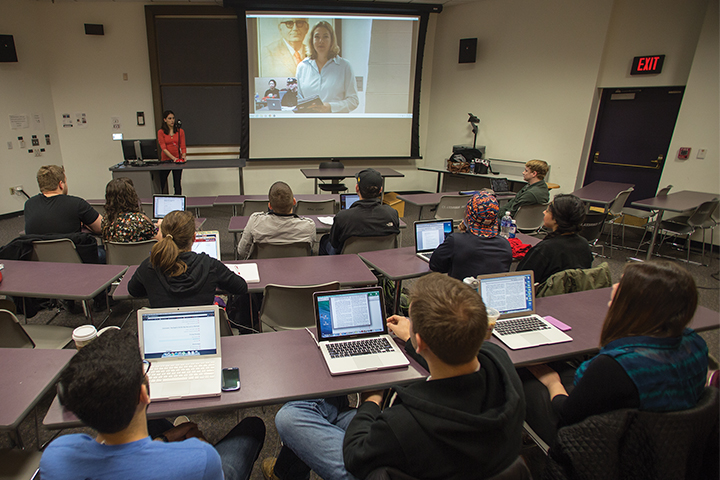
University students listen to Anat Stern, a professor whose lectures are streamed from Tel Aviv during class.
When university President Wallace Loh visited the Middle East in April, he returned with some new additions.
Loh signed academic partnerships with several universities in Israel and Jordan in an effort to globalize this university and strengthen its relationships with those institutions.
Almost a year after the agreement, university students are able to learn with students at Tel Aviv University through video-conference software in an Israel studies class.
“I was glad [for the collaboration] because of the connection,” said Paul Scham, visiting professor and Gildenhorn Institute for Israel Studies executive director. “I think for someone who teaches about Israel, the sense of connection is important in ways we don’t see, we don’t realize.”
As the first effort in cohesion with the agreement to globalize the classroom, an 18-person class — ISRL 359A: Israel Studies Global Classroom; Conflicts and Challenges in Israel 1948-1967 — launched this semester, allowing a professor in Tel Aviv to teach students in the city and at this university simultaneously.
Scham, Gov. Martin O’Malley and Yoram Peri (professor and Gildenhorn Institute director) were all involved in the initial collaboration. This state and Israel already have close ties economically and socially, Peri said, but on his most recent trip, O’Malley wanted to incorporate an academic tie.
“You open the door to wonderful new ideas of learning,” Peri said. “It’s the beginning of new higher education.“
While Scham and Peri organized the course on this campus and act as the facilitators, the official professor for the class is Anat Stern from Tel Aviv, who instructs from Israel.
Because Tel Aviv’s second semester did not begin until Feb. 16, the professors at this university gave in-class lectures for three classes before video conferencing began Feb. 17. The three-and-a-half hour course is not just a lecture; the second half involves a discussion-based period for students in both classrooms to interact with one another.
The students enrolled in the class at Tel Aviv University include a wide variety of international students with different backgrounds and countries of origin, Scham said.
A class and partnership like this also encourages students to visit the country, Peri said, because there are many opportunities to do so while learning about it interactively.
Junior geographical sciences major Mohamad Ibrahim has never visited Israel, but because there are several students on the campus who have, he said being in the class makes it easy for them to relate to the topic.
“It allows for better access to a lot of experts,” Ibrahim said. “ It’s an intelligent topic, and the fact that it’s taught like this is amazing.”
Peri said the partnership could be used within other disciplines or in other countries, but more intricate classes might require more preparation and research.
“This is only the beginning, but the idea is to go beyond Tel Aviv and UMD,” Peri said.
Scham said they expect to see more partnerships like this in the future, and “in five to 10 years, this will be the norm,” he said.
There were some technical problems on the first day of video conferencing, such as picture clarity and sound issues, but everything is now functioning, Scham said.
“We’re experimenting with how things will work best for everyone; we’re just learning how to use this medium,” Scham said. “It’s not a technical question, but it’s, ‘How can we use this technology as it becomes easier and available?’”
Daniella Berger, a sophomore government and politics and history major, is enrolled in the class as a part of her Middle Eastern studies concentration. Despite the initial technology errors, she said the class feels normal and engaging.
“[Stern] is very charismatic. She definitely does a good job to get people to talk,” she said.
While the format seems to work for the class, Berger said it would be harder to use this type of learning for more hands-on, group project-based classes.
Ibrahim’s love for history brought him to the course initially, he said, not knowing the class was based upon virtual enrollment.
“The history of the Middle East is something that’s central to who I am, and I want to learn about it from the other side,” Ibrahim said. “There’s no defined ‘this is what it is.’”
While watching the class unfold on a large screen can sometimes feel distracting, he said, the students in Tel Aviv have such a wide range of backgrounds that it is “intimidating and exciting at the same time.”
“We should be very proud,” Peri said. “In less than a year, we were able to develop this.”
Peri said there are several ways to study while using Internet resources, but this type of classroom opens “a new horizon” for progressive methods of studying.
“This is the new world,” Peri said. “Go beyond the parochial approach.”



